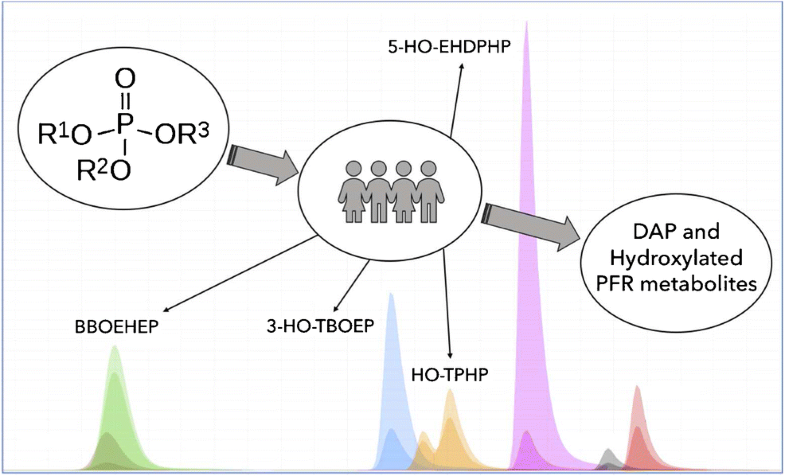Analytical and Bioanalytical Chemistry ( IF 4.3 ) Pub Date : 2018-10-05 , DOI: 10.1007/s00216-018-1402-2 Michiel Bastiaensen , Fuchao Xu , Frederic Been , Nele Van den Eede , Adrian Covaci
Organophosphate flame retardants and plasticizers (PFRs) are a group of chemicals widely added to consumer products. PFRs are quickly metabolized in the human body into two types of metabolites, (1) dialkyl and diaryl phosphate esters (DAPs), such as diphenyl phosphate (DPHP) and bis(1,3-dichloro-2-propyl) phosphate (BDCIPP); and (2) hydroxylated PFRs (HO-PFRs), such as 1-hydroxy-2-propyl bis(1-chloro-2-propyl) phosphate (BCIPHIPP) and 2-hydroxyethyl bis(2-butoxyethyl) phosphate (BBOEHEP). Existing analytical methods usually focus on DAPs; therefore, human biomonitoring data on HO-PFRs remain scarce. In this study, an analytical procedure was developed for the simultaneous quantification of multiple PFR metabolites in human urine, covering eight DAPs and six HO-PFRs. Sample preparation was optimized to include all target compounds using Bond-Elut C18 solid-phase extraction cartridges, followed by instrumental analysis based on liquid-chromatography coupled to tandem mass spectrometry (LC-MS/MS). Method performance was validated according to established guidelines and satisfactory results were obtained for all metabolites in terms of recovery, linearity, limits of quantification, precision, and accuracy. Recoveries ranged from 87 to 112%. Method detection limits from 0.002 ng/mL for 2-ethyl-5-hydroxyhexyl diphenyl phosphate (5-HO-EHDPHP) to 0.66 ng/mL for 4-hydroxyphenyl phenyl phosphate (4-HO-DPHP). Seven PFR metabolites were frequently detected in a small biomonitoring study (n = 14), among them bis(1,3-dichloro-2-propyl) phosphate (BDCIPP), di-n-butyl phosphate (DNBP), 5-HO-EHDPHP, and BBOEHEP. Highest mean concentrations were found for DPHP, 2-ethylhexyl phenyl phosphate (EHPHP), and BCIPHIPP, while 4-HO-DPHP, 5-HO-EHDPHP, and EHPHP were detected in urine for the first time. Overall, the obtained results demonstrate that the developed method can be used for the simultaneous determination of 14 urinary biomarkers of exposure to PFRs.

ᅟ
中文翻译:

通过LC-MS / MS同时测定14种暴露于有机磷酸酯阻燃剂和增塑剂中的尿液生物标志物
有机磷酸酯阻燃剂和增塑剂(PFR)是广泛添加到消费产品中的一组化学物质。PFR在人体中迅速代谢为两种类型的代谢物,(1)磷酸二烷基酯和二芳基磷酸酯(DAP),例如磷酸二苯酯(DPHP)和磷酸双(1,3-二氯-2-丙基)酯(BDCIPP) ; (2)羟基化的PFR(HO-PFR),例如1-羟基-2-丙基双(1-氯-2-丙基)磷酸酯(BCIPHIPP)和2-羟基乙基双(2-丁氧基乙基)磷酸酯(BBOEHEP)。现有的分析方法通常集中于DAP。因此,关于HO-PFR的人体生物监测数据仍然匮乏。在这项研究中,开发了一种分析程序,用于同时定量人类尿液中多种PFR代谢物,涵盖了8个DAP和6个HO-PFR。使用Bond-Elut C18固相萃取小柱对样品制备进行了优化,以包括所有目标化合物,然后基于液相色谱-串联质谱(LC-MS / MS)进行仪器分析。根据既定的指导原则对方法的性能进行了验证,并且在回收率,线性,定量限,精密度和准确性方面,所有代谢物均获得了满意的结果。回收率介于87%至112%之间。方法检测限从2-乙基-5-羟基己基二苯基磷酸酯(5-HO-EHDPHP)的0.002 ng / mL到4-羟基苯基苯基磷酸酯(4-HO-DPHP)的0.66 ng / mL。在一项小型生物监测研究中,经常检测到7种PFR代谢物(然后进行基于液相色谱-串联质谱联用(LC-MS / MS)的仪器分析。根据既定的指导原则对方法的性能进行了验证,并且在回收率,线性,定量限,精密度和准确性方面,所有代谢物均获得了满意的结果。回收率介于87%至112%之间。方法检测限从2-乙基-5-羟基己基二苯基磷酸酯(5-HO-EHDPHP)的0.002 ng / mL到4-羟基苯基苯基磷酸酯(4-HO-DPHP)的0.66 ng / mL。在一项小型生物监测研究中,经常检测到7种PFR代谢物(然后进行基于液相色谱-串联质谱联用(LC-MS / MS)的仪器分析。根据既定的指导原则对方法的性能进行了验证,并且在回收率,线性,定量限,精密度和准确性方面,所有代谢物均获得了满意的结果。回收率介于87%至112%之间。方法检测限从2-乙基-5-羟基己基二苯基磷酸酯(5-HO-EHDPHP)的0.002 ng / mL到4-羟基苯基苯基磷酸酯(4-HO-DPHP)的0.66 ng / mL。在一项小型生物监测研究中,经常检测到7种PFR代谢物(回收率介于87%至112%之间。方法检测限从2-乙基-5-羟基己基二苯基磷酸酯(5-HO-EHDPHP)的0.002 ng / mL到4-羟基苯基苯基磷酸酯(4-HO-DPHP)的0.66 ng / mL。在一项小型生物监测研究中,经常检测到7种PFR代谢物(回收率介于87%至112%之间。方法检测限从2-乙基-5-羟基己基二苯基磷酸酯(5-HO-EHDPHP)的0.002 ng / mL到4-羟基苯基苯基磷酸酯(4-HO-DPHP)的0.66 ng / mL。在一项小型生物监测研究中,经常检测到7种PFR代谢物(n = 14),其中包括磷酸双(1,3-二氯-2-丙基)酯(BDCIPP),磷酸二正丁酯(DNBP),5-HO-EHDPHP和BBOEHEP。发现DPHP,2-乙基己基苯基磷酸酯(EHPHP)和BCIPHIPP的最高平均浓度,而首次在尿液中检测到4-HO-DPHP,5-HO-EHDPHP和EHPHP。总体而言,获得的结果表明,所开发的方法可用于同时测定14种暴露于PFR的尿液生物标志物。

ᅟ



























 京公网安备 11010802027423号
京公网安备 11010802027423号